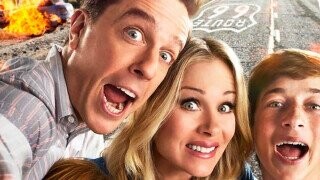4 Failed Reboots That Got At Least One Thing Right

It’s certainly no secret that Hollywood’s dream factory has become more of a recycling plant for remakes, reboots and remakes of rebooted remakes. After all, cruising IMDb for familiar intellectual properties that will tickle America’s nostalgia bone is a far more easier task than coming up with brand-new original ideas.
Click right here to get the best of Cracked sent to your inbox.
Don't Miss
Some of these attempts to revive old franchises have comedically crashed and burned, ultimately failing to yield any further sequels. But not every aspect of these “failed” reboots were total misfires; it turns out that some of them managed to make at least one solid creative choice, such as how…
‘Vacation’ Wisely Cast Chris Hemsworth Instead of a Randy Quaid-Type
The idea of rebooting a Chevy Chase franchise with way less “having to deal with Chevy Chase all the time” was presumably a welcome one (see also: Confess, Fletch). But audiences were quick to dismiss the 2015 Ed Helms-starring Vacation reboot, which is too bad because it’s actually a pretty solid comedy. Vacation mostly follows the original film’s formula, beat for beat, but with the occasional curveball — like the scene in which a flirtatious blonde in a red sports car is suddenly pancaked by a Mack truck.
When the Griswold clan pauses their road trip to visit family, instead of being hosted by a white trash dirtbag, like in the original, Rusty’s source of irritation is his sister Audrey’s husband Stone: a ripped, wealthy Southerner played by Chris Hemsworth.
This was a smart move, as making fun of present-day Randy Quaid is like shooting paranoid fish in a barrel that fled to Canada. Sure, he was funny, but that joke was already played out even before we got Christmas Vacation 2: Cousin Eddie’s Island Adventure. Not only is Hemsworth hilarious in his own right, but by flipping the character from a Quaid-type to a God of Thunder-type, Vacation 2.0 makes Rusty’s male insecurity the butt of the joke.
The Ecto-1 in the 2016 ‘Ghostbusters’ Is an Improvement Over the Original
The 2016 Ghostbusters remake took a lot of crap from angry, overindulged man-babies unable to stand the thought of four women taking the place of the beloved disgraced academic sex criminals they grew up with. But even putting these dumb complaints aside, the movie is certainly not without its flaws. The scene in which the Ghostbusters seemingly murder Bill Murray’s character and no one gives a damn definitely springs to mind.
But the new movie also makes at least one improvement to the first. The Ghostbusters’ original iconic ride, the Ecto-1, was a modified 1959 Cadillac Miller-Meteor, used in its time as either an ambulance or a hearse. The new Ecto-1 further underscored the car’s symbolic meaning by making it a straight-up former hearse — and really, it just makes sense that the Ghostbusters are driving around in a conspicuous representation of death.
It boasts a snazzy red roof and a ghostly hood ornament, too. It’s a hell of a Ghostbusting vehicle that we’ll sadly probably never see again because even Sony is trying to pretend like this movie never happened.
‘The Predator’ Gave Us Sterling K. Brown’s A+ Villainous Bro
Shane Black’s The Predator was kind of a disaster — not only was it the first entry in the series to cast a real-life predator in a role, but it also, arguably, ruined the entire message of the original movie.
But the film wasn’t a total write-off since it also featured one of the best villains in recent movie history; a villainous military goon played by Sterling K. Brown. What could have been a completely forgettable character was instead fashioned as an unhinged bro who’s either screaming his head off or being hilariously chill about the captured dead alien monster.
The movie is worth watching solely for Brown’s villain, the kind of baddie one would expect to see in a cocaine-fueled VHS oddity from the Reagan era, not a 21st-century blockbuster. He may be the greatest Predator franchise antagonist besides the Predator himself (and also testosterone).
‘Men in Black: International’ Returned to Themes of Immigration
The first attempt to make a Men in Black movie without having to shell out millions of dollars to pay Will Smith and Sourpuss McCrank (aka Tommy Lee Jones) resulted in 2019’s Men in Black: International, starring Tessa Thompson and Chris Hemsworth (who is apparently the king of remaking decades-old comedies).
International’s lukewarm reception may have killed off the Men in Black franchise (for now), but it did at least restore the series’ original thematic focus: immigration. The first film is a thinly-veiled allegorical argument for “compassionate immigration policy,” with the Men in Black repeatedly highlighting the importance and communal benefits of Earth’s extraterrestrial immigrants. Though, to be fair, the Men in Black also maintain a policy of occasionally shooting aliens until they explode in a torrent of Nickelodeon slime.
International similarly tapped into these themes and attempted a commentary on Trump-era xenophobic paranoia by ultimately revealing that (SPOILERS for a movie you’re probably never going to see if you haven’t already) the movie’s head Man in Black (played by Liam Neeson) has been unjustly vilifying alien migrants and is in cahoots with the film’s antagonist. Also, he’s now a giant tentacle creature, presumably because Neeson was busy filming a Taken movie that week.
According to reports, the political commentary was originally going to be even more pointed; however, these elements were ultimately watered down in favor of more scenes featuring Hemsworth brawling with goofy CGI monsters.
You (yes, you) should follow JM on Twitter (if it still exists by the time you’re reading this).